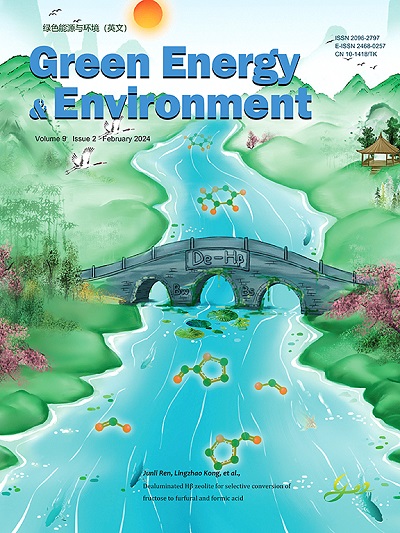将 2,6-二氨基蒽醌修饰的 MXene(Ti3C2Tx)/石墨烯作为离子液体型不对称超级电容器的负极材料
IF 14.6
1区 工程技术
Q1 CHEMISTRY, PHYSICAL
引用次数: 0
摘要
由于能量密度不足,具有卓越功率和长周期稳定性的超级电容器(SC)在某些实际应用中无法实现。探索具有氧化还原活性的混合材料,在离子液体(IL)电解质中产生高比电容,可以解决这一问题。在此,我们报告了一种氧化还原有机分子 2,6-二氨基蒽醌(DAAQ)修饰的 MXene(TiCT)/石墨烯(DAAQ-M/G)复合材料。在氧化石墨烯(GO)的辅助下,MXene 和石墨烯形成了三维(3D)互连结构作为导电框架,从而抑制了 MXene 单层的自堆积,确保了高电子导电性。同时,通过共价/非共价官能化将 DAAQ 加载到 M/G 框架上。作为间隔物的 DAAQ 有效地扩大了 MXene 纳米片的层间间距,同时在充放电过程中产生可逆的氧化还原反应,为电容提供额外的法拉第贡献。因此,在 1-ethyl-3-methylimidazolium tetrafluoroborate (EmimBF) 电解液中,DAAQ-M/G 作为负极材料的比电容(容量)在 1 A g 时达到 226 F g (306 C g)。此外,以 DAAQ-M/G 为负极,以自制备的有机分子对苯二酚修饰的还原型氧化石墨烯(HQ-RGO)材料为正极,组装了不对称超级电容器(ASC),在 1669 W kg 的高功率密度下,能量密度高达 43 Wh kg。ASC 可在 9000 次循环后保持初始比电容的 80%。这项研究可为开发先进的有机分子改性 MXene 复合材料提供更好的支持,用于离子液体型 SC。本文章由计算机程序翻译,如有差异,请以英文原文为准。
2,6-Diaminoanthraquinone modified MXene (Ti3C2Tx)/graphene as the negative electrode materials for ionic liquid-based asymmetric supercapacitors
Due to insufficient energy density, supercapacitors (SCs) with preeminent-power and long cycle stability cannot be implemented in some practical applications. Exploring hybrid materials with redox activity to emerge high specific capacitance in ionic liquid (IL) electrolytes can solve this problem. Herein, we report a redox-organic molecule 2,6-diaminoanthraquinone (DAAQ) modified MXene (TiCT)/Graphene (DAAQ-M/G) composite material. With the assist of graphene oxide (GO), MXene and graphene fabricate a three-dimensional (3D) interconnected structure as a conductive framework, which inhibits self-stacking of MXene monolayers and ensures high electronic conductivity. Meanwhile, DAAQ is loaded onto the M/G framework through covalent/non-covalent functionalization. The DAAQ as a spacer effectively enlarges the interlayer spacing of MXene nanosheets, and meanwhile produces reversible redox reactions during charge/discharge processes to provide additional Faradaic contribution to capacity. Therefore, the specific capacitance (capacity) of the DAAQ-M/G as the negative electrode material reaches to 226 F g (306 C g) at 1 A g in 1-ethyl-3-methylimidazolium tetrafluoroborate (EmimBF) electrolyte. Furthermore, an asymmetric supercapacitor (ASC) is assembled using DAAQ-M/G as the negative electrode and self-prepared organic molecule hydroquinone modified reduced graphene oxide (HQ-RGO) material as the positive electrode, with a high energy density of 43 Wh kg at high power density of 1669 W kg. The ASC can maintain 80% of initial specific capacitance after 9000 cycles. This research can provide better support to develop advanced organic molecules-modified MXene composite materials for ionic liquid-based SCs.
求助全文
通过发布文献求助,成功后即可免费获取论文全文。
去求助
来源期刊

Green Energy & Environment
Energy-Renewable Energy, Sustainability and the Environment
CiteScore
16.80
自引率
3.80%
发文量
332
审稿时长
12 days
期刊介绍:
Green Energy & Environment (GEE) is an internationally recognized journal that undergoes a rigorous peer-review process. It focuses on interdisciplinary research related to green energy and the environment, covering a wide range of topics including biofuel and bioenergy, energy storage and networks, catalysis for sustainable processes, and materials for energy and the environment. GEE has a broad scope and encourages the submission of original and innovative research in both fundamental and engineering fields. Additionally, GEE serves as a platform for discussions, summaries, reviews, and previews of the impact of green energy on the eco-environment.
 求助内容:
求助内容: 应助结果提醒方式:
应助结果提醒方式:


